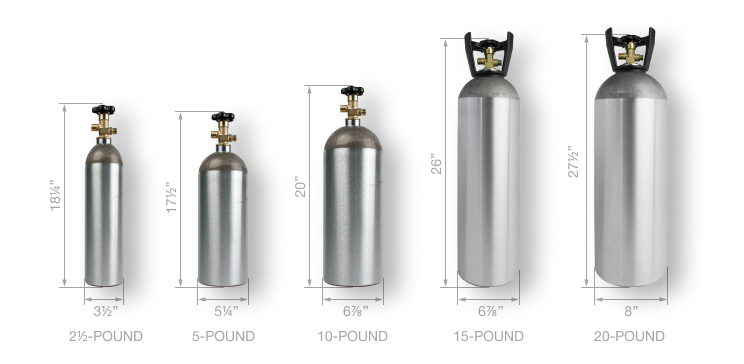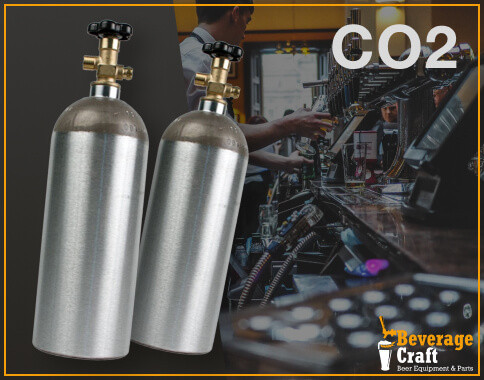All You Need to Know About CO2 Tanks for Beer Carbonation
Posted by Ron on 6th Apr 2021
Carbonation is fairly simple. Some say that all you have to do is take a CO2 tank for a keg, connect it, and that’s it! Well, not exactly. When it comes to using a CO2 tank for beer carbonation and homebrewing, there are quite a few nuances you should be aware of, from choosing the right size to making the proper connections.
That’s why you’ve got Beverage Craft specialists to let you in on all of these nuances. Let’s take a look!
What Sizes Do CO2 Tanks Come In?
When choosing for a CO2 tank, one of the first things you have to decide is what size you need. For our, homebrewers’ convenience, there is a wide variety of CO2 tank sizes - from really small, compact ones to really big, almost-impossible-to-lift ones.
Here are some of the most common CO2 tank and CO2 bottle sizes found on the homebrewing market. You'll see the width and height in the brackets to give you an idea of the CO2 cylinder size and whether you can fit it where you want it to be:
- 2½-pound cylinder (3½’’W x 18¼’’H)
- 5-pound cylinder (5¼’’W x 17½’’H)
- 10-pound cylinder (6⅞’’W x 20’’H)
- 15-pound cylinder (6⅞’’W x 26’’H)
- 20-pound cylinder (8’’W x 27½’’H)

Naturally, you don’t need to buy a new CO2 tank every time your old one runs out of gas. Most homebrewers refill their tanks - this can be done at a draught beer store, welding supply store, fire extinguisher store, or any other place in your area that sells CO2 equipment.
What Size CO2 Tank for Homebrew
If you’re still asking yourself “what size CO2 tank should I get?” we can help you out with a few common tips. The basic idea is this: what size CO2 tank for keg you should get for your brewing equipment depends mainly on three things:
- the type of kegs and beer (and therefore, pressure) you are using
- how often you would like to refill your CO2 tank
- how comfortable you are with a particular keg size and weight
Plus, there’s the price factor as well - obviously, bigger tanks will cost you more. For example, if your homebrewing equipment features corny kegs (5-gallon capacity), a small 2½-pound CO2 tank will dispense for about 7 to 11 kegs while a 10-pound CO2 tank can last up to 44 kegs.
How to Use a CO2 Tank: Tips and Warnings
Learning how to use a CO2 tank is not really difficult. The two most common problems you might run into are connecting the tank properly and setting the right pressure. Let’s see how it’s done.
To connect your CO2 tank for beer, you need to do the following:
- connect the CO2 regulator to the CO2 cylinder and securely tighten the tank nut to prevent gas leaks
- attach the CO2 gas tubing (aka “the air line”, usually red) to the CO2 regulator outlet nipple and secure it with a clamp
- connect the other end of the gas tubing to the CO2 pressure inlet nipple on the keg coupler and secure it with a clamp as well
Now it’s time to open the CO2 cylinder valve. When you do so, open it all the way to be sure there are no leaks. After that, it’s time to move on to the pressure settings - for most beers other than stouts, 12 psi should be perfect.
Setting the right pressure for CO2 tanks for kegerators is important because it prevents over- or under-carbonation and generally ensure the keg remains perfectly balanced throughout its service life.
What Is the Pressure in a CO2 Cartridge?
CO2 cartridges are tiny little containers made of steel, filled with 100% pure CO2. How much pressure does a CO2 cartridge hold? Typically, it’s around 900 psi at room temperature however, it may decrease when the ambient temperature is low and increase when it’s hot.
To check the gas pressure on your CO2 tank, take a look at the primary and secondary regulators. The primary regulator shows the output CO2 pressure while the secondary regulator shows how much CO2 you have left in the tank.
For a better pour, you can use the flow control faucet to reduce foam and the pressure reducer to accommodate various styles of beer.
How Many Kegs You Get Out of a CO2 Tank
Now, to the practical side of the question. If you want to know, for example, how many kegs will a 5-pound CO2 tank will dispense, please refer to the table below.
Here, you can see the approximate number of kegs that can be dispensed using a certain type of CO2 tank and how much is a CO2 tank for a kegerator is going to last you.
| 2½ Pound Cylinder | 5 Pound Cylinder | 10 Pound Cylinder | 15 Pound Cylinder | 20 Pound Cylinder | |
| Homebrew
(5 gallons) |
7-11 | 15-22 | 31-44 | 46-66 | 62-87 |
| Corny keg
(5 gallons) |
7-11 | 15-22 | 31-44 | 46-66 | 62-87 |
| Sixth barrel
(5.23 gallons) |
7-11 | 14-21 | 29-42 | 44-63 | 59-83 |
| Quarter barrel
(7.75 gallons) |
5-7 | 10-14 | 20-28 | 30-42 | 40-56 |
| Half barrel
(15.50 gallons) |
2-4 | 5-7 | 10-14 | 15-21 | 20-28 |
How Long Does a CO2 Cartridge Last for Serving a Keg?
So, how long do CO2 cartridges last? Again, it all depends on the size of the keg. If we’re talking a quarter barrel of draught beer (7.75 gallons), it will take about half a pound of CO2 to dispense it.
However, if you, like most homebrewers, prefer to use 5-gallon kegs (Corny kegs), you will be able to dispense about 31 to 44 kegs of beer with a 5-pound CO2 tank.
What about portable cartridges? How long do CO2 cartridges last keg-wise? Well, one 16-gram CO2 cartridge will last for about one third of a Corny keg. A larger-size, 68 grams cartridge will last you from 1 up to 4 kegs.
We recommend keeping CO2 cylinders out of the fridge to avoid a decrease in pressure. For example, dispensing a regular North American Lager (like a Budweiser, Miller, or Coors) is half a pound for each half barrel keg provided the CO2 is stored at room temperature.

